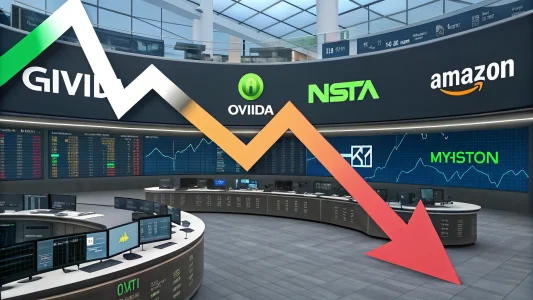Unlike other forms of investment income that fluctuate wildly with market conditions, dividends provide a more stable and predictable income stream, which can be particularly appealing for those in retirement.
The beauty of dividend investing is that it preserves the potential for income generation and capital growth. By carefully selecting companies with a strong track record of dividend payments, retirees can benefit from regular, reliable payments that help cover living expenses without eroding the principal investment.
To sweeten the pot further, if you reinvest your dividends, you can use compound growth, potentially adding large sums to your gains over a long timeframe.
That said, for all the benefits, dividend investing is far from a simple strategy. We’re talking about significant benefits here—steady payments, long-term sustainability, and the ability to maintain or enhance your lifestyle without savings—and that requires a bit of legwork.
However, the payoff is well worth the reward—and we will do our part to help you achieve those goals. Without further ado, let’s delve into how dividends work, how to identify the best dividend-paying investments, and how to keep your portfolio profitable and balanced in the long run.
Table of Contents
ToggleUnderstanding Dividends
Dividends are payments a business makes to its shareholders, usually derived from the company’s profits.
When a company earns a profit, it can choose to reinvest it in the business (called retained earnings) or distribute it to shareholders as a dividend. These payments are often made regularly (monthly, quarterly, biannually, or annually) and can be issued in cash or as additional shares of stock.
How Dividends Work
The dividend distribution process begins with the company’s board of directors declaring a dividend.
This declaration includes the size of the dividend, the record date (the date you must be on the company’s books as a shareholder to receive the dividend), and the payment date.
Once dividends are declared, they become the company’s liability and must be paid out on the scheduled payment dates. Dividends are typically paid per share, meaning that the more shares you own, the larger your payout.
Dividends are divided into three subtypes:
- Regular dividends — distributed as part of the typical cycle of dividend payments according to the company’s established dividend policy.
- Special dividends — occasionally, a company might pay a dividend not part of the regular cycle, often to distribute unusually high profits from a windfall.
- Stock Dividends — companies may issue additional shares instead of cash as a form of dividend.
Why Dividends Are a Viable Option for Income
For retirees, dividends offer a particularly attractive income source. They provide a steady stream of income, which can be a great boon for managing living expenses—without depleting the principal investment. Here are several reasons why dividends are a popular choice for income:
- Predictability: Dividends provide regular income, which can be predicted and planned for, unlike capital gains, which can be irregular and unpredictable.
- Lower Volatility: Stocks that pay regular dividends tend to be less volatile than non-dividend-paying stocks.
- Tax Advantages: In many jurisdictions, dividends are taxed at a lower rate than other forms of income, such as interest income or capital gains.
- Compounding: Reinvesting dividends can lead to compound growth, increasing the value of your investment over time.
Why Choose Dividend Stocks
Dividend stocks are a cornerstone for generating passive income, particularly attractive for retirees or those seeking consistent cash flow.
By investing in dividend-paying companies, investors receive regular payouts that can supplement other sources of income. This passive income stream requires little to no day-to-day management, making it an ideal strategy for those who wish to focus on enjoying retirement rather than managing complex investments.
Inflation Hedging Capabilities
One significant advantage of dividend stocks is their potential to hedge against inflation. As the cost of living increases, companies that generate higher revenues can afford to increase their dividend payouts.
Many dividend-paying companies are established, financially stable, mature businesses that can raise dividends over time. This increase in dividends can help maintain the purchasing power of your investment returns during inflationary periods, protecting your income against the erosion of value that inflation can cause.
Favorable Tax Treatment
Dividend income often benefits from more favorable tax treatment than other income types, such as interest or non-qualified stock gains.
In many jurisdictions, qualified dividends are taxed at a lower rate than ordinary income, which can significantly enhance the after-tax return on these investments. This tax efficiency makes dividend stocks attractive for investors looking to maximize their investment income while minimizing tax liabilities.
Additional Points to Keep in Mind
Dividend-paying stocks often belong to industries and sectors known for their stability and steady growth. Investing in these stocks can provide a reliable income stream and the potential for capital appreciation.
Another appealing aspect of dividend stocks is their role in portfolio stability. Dividend payouts can act as a cushion during market downturns. When stock prices fall, the dividend yield effectively increases, providing a higher return on the lower price. This can make dividend stocks particularly attractive during volatile market periods, offering a semblance of income stability in an otherwise uncertain investment landscape.
Furthermore, dividends can be reinvested to purchase additional shares, compounding the benefits by increasing the potential future income and growth of your investment portfolio.
Criteria for Selecting the Right Stocks
When selecting dividend-paying stocks, the first criterion to consider is the overall health and performance of the company.
Look for companies with a consistent track record of profitability and strong financial health. Financial stability is crucial because it indicates a company’s ability to sustain and potentially increase dividend payouts.
Keep your eye on key financial metrics such as earnings growth, return on equity, and debt-to-equity ratio to ensure the company stands on solid ground.
Understanding Dividend Yield
Dividend yield is critical in choosing the right stocks for income generation. It represents the percentage of your investment that you receive back each year from dividends alone.
While a high dividend yield may seem attractive, it’s essential to consider it in the context of the market and other stocks in the same industry. Extremely high yields can sometimes be a red flag for financial distress or a dividend that may not be sustainable in the long term.
Aim for companies with yields that are competitive yet realistic within their sector. Investors should consider the dividend coverage ratio, which measures a company’s ability to pay its current dividend based on its net income.
A higher coverage ratio indicates a more sustainable dividend, showing that the company is not overextending itself by paying out more in dividends than it earns. This metric can provide an added layer of security for retirees seeking reliable income streams from their investments.
Considering Dividend Growth and Consistency
Beyond the current yield, look at the dividend growth rate and the consistency of payouts. Companies with a history of steadily increasing their dividends are often financially healthy and confident in their future cash flows.
These companies are typically regarded as Dividend Aristocrats or Dividend Kings, having consecutively raised dividends for 25+ years. Consistent dividend growth can not only counteract the effects of inflation but also indicate a commitment to shareholder returns.
Another crucial criterion for selecting the right dividend-paying stocks is the company’s market position and competitive advantage, referred to as its economic moat. Companies with a wide economic moat have sustainable competitive advantages that protect them from losing market share to others in their respective sectors or industries.
These advantages could include brand recognition, proprietary technology, regulatory licenses, or a dominant market share. Such attributes make it more likely for the company to maintain profitability and continue its dividend payouts, which is essential for long-term investment strategies.
Evaluating Risk Tolerance
Individual risk tolerance is a pivotal factor in stock selection. If you prefer lower risk, consider stocks in stable industries with a long history of dividend payments.
Utilities and healthcare are traditionally less volatile. However, if you are willing to accept higher risk for potentially greater returns, you might look into sectors like technology or consumer discretionary, which can offer higher growth potential but with more significant price swings and less predictable dividends.
Building a Diverse Dividend Portfolio
Diversification is a fundamental investment strategy to reduce risk by spreading investments across various sectors and industries.
For dividend investors, diversification helps mitigate the impact of sector-specific downturns, ensuring a more stable income stream. Investing in a broad array of companies reduces the risk that a failed investment could significantly harm your financial health.
When building a dividend portfolio, consider including a mix of sectors known for reliable and growing dividends, such as utilities, consumer staples, healthcare, and real estate — with REITs, in particular, being a strong choice when talking about real estate investments.
Expanding beyond traditional sectors, investors can also consider incorporating emerging industries that show potential for stable and increasing dividends in the future.
Sectors like renewable energy, expected to grow due to increasing global energy demands and a shift towards sustainable practices, could be a strategic addition. While these sectors may currently offer lower dividends, their growth potential could lead to substantial dividend increases as the industries mature.
Geographic diversification is another essential factor in building a robust dividend portfolio. By investing in dividend-paying companies across different countries, investors can tap into varying economic cycles and opportunities that might not be present in their domestic market.
Balancing High-Yield and Growth Stocks
Achieving a balance between high-yield stocks and growth stocks is crucial. High-yield stocks offer higher dividends but can sometimes have slower growth in stock price. They are attractive for immediate income but carry risks if the high yield is not sustainable. Growth stocks may offer smaller initial dividends but have the potential for significant price appreciation and dividend growth over time.
Investors should aim for a portfolio that provides a good return in the form of dividends and has the potential for capital appreciation. Adjusting the mix according to market conditions and personal financial goals is essential, as this balance will shift depending on economic environments and life stages.
Continuous Portfolio Assessment
It is vital to regularly review and adjust your portfolio. Market dynamics and company fundamentals can change, influencing which stocks are favorable for dividend income and growth potential. Keeping abreast of these changes and rebalancing your portfolio accordingly will help maintain its health and profitability over the long term.
It’s also crucial to consider the liquidity of dividend stocks in your portfolio. Highly liquid stocks can be bought or sold quickly in the market without a significant price change.
This can be particularly important for retirees who might need to adjust their portfolios quickly in response to personal financial needs or market changes. Stocks with higher liquidity typically have more stable prices, which can help reduce the overall volatility of your investment portfolio.
Risk Management
Managing risks in dividend investing involves a strategic approach to selecting and maintaining a balanced portfolio.
High-yield stocks, while tempting due to their potential for substantial income, can also present significant risks. These stocks might be delivering high dividends not from operational strength but from a struggling business trying to attract investors, which could lead to unsustainable payouts and possible cuts in the future.
To mitigate these risks, thorough due diligence is essential. Analyzing a company’s payout ratio, which compares the dividend per share with the net income per share, provides insight into how much income the company is returning to shareholders versus what it retains for growth while looking at historical volatility will give you an idea as to how the stock reacts to market changes.
A very high payout ratio could signal that dividends are at risk if earnings fall. Similarly, assessing the company’s debt levels is crucial; companies with high debt may not sustain high dividends if financial conditions deteriorate.
Furthermore, diversification across various sectors and industries can help reduce the risk of exposure to a single economic event impacting all your investments. This strategy spreads out potential negative outcomes across a broader array of assets, thereby reducing the impact of a single failing investment.
Regular portfolio reviews are also critical in risk management. This practice involves evaluating each investment’s performance and role within the broader portfolio context, adjusting to align with changing market conditions and personal financial goals.
Tax Planning and Cost Control
Tax planning and cost control are crucial for maximizing the efficiency and returns from dividend investing. Dividend income can be taxed as qualified or non-qualified, with qualified dividends benefiting from lower tax rates akin to long-term capital gains, contingent on specific holding periods and the type of company issuing the dividend.
Investors should optimize their tax exposure by holding dividend stocks in tax-advantaged accounts such as IRAs or 401(k)s, where dividends can grow either tax-deferred or tax-free, depending on the account type.
To minimize investment costs, selecting low-fee brokerage platforms is essential. Frequent trading not only triggers trading fees and commissions but can also lead to higher tax liabilities.
Employing a buy-and-hold strategy not only minimizes these costs but also aligns with the favorable tax treatment of long-term investments. Additionally, investors should choose mutual funds and ETFs without transaction fees and low expense ratios to avoid eroding their dividend gains.
Investors can also reduce costs by planning their trades around tax events, taking advantage of tax loss harvesting, and strategically timing the buying and selling of securities to optimize tax implications. Keeping informed about changes in tax laws and understanding how they affect investment activities is also vital for long-term success.
Long-Term Planning
An effective long-term strategy involves evaluating and selecting dividend-paying stocks that offer immediate returns and sustainable growth, supporting current and future financial needs. This involves understanding the historical performance of these stocks and their potential to increase dividend payouts in response to inflation and changing economic conditions.
Investors should also assess their risk tolerance regularly, especially as they approach retirement. A portfolio that was suitable in earlier years might need adjustments to reduce risk and ensure more stability. Investors should balance their need for immediate income with the potential for long-term capital appreciation.
Adapting to reflect changes in personal circumstances, market conditions, and financial goals is essential. Investing might mean shifting from high-yield stocks to those with stronger growth potential or vice versa, depending on the current economic outlook and personal risk profile. If you’re a business owner, it could mean pivoting to alternative cash flow solutions like invoice financing, expanding into new markets, or even downsizing. It could also entail finding a side job or additional income streams.
Regular portfolio reviews and adjustments ensure that investments align with an individual’s retirement timeline and financial objectives. This dynamic approach to portfolio management not only protects against potential downturns but also positions investors to capitalize on growth opportunities, ensuring that their retirement savings continue to work effectively for them as their needs and the external economic environment evolve.
Conclusion
Dividends are often underappreciated—however, numbers don’t lie, and dividends have contributed just short of a third (32%) to overall S&P 500 returns since 1926. Not tapping into such a significant source of returns would be a huge and costly mistake.
Exactly how much of your portfolio you will commit to dividend-paying investments is up to you — but with economic cycles, recessions, and the volatility of equities, having a stable source of passive income is a prudent choice—for all of us.
Regarding retirement, this regular income provides a steady cash flow, dependable payments, and the ability to maintain your lifestyle without worrying that you’ll be jeopardizing your future.
Although it isn’t exactly a walk in the park, with meticulous planning, a reasonable, grounded plan, and ongoing reviews, you can reap the advantages of passive income and compound interest, making a stable retirement free from worries one step closer to becoming a reality.
Featured Image Credit: Photo by Tima Miroshnichenko; Pexels
















